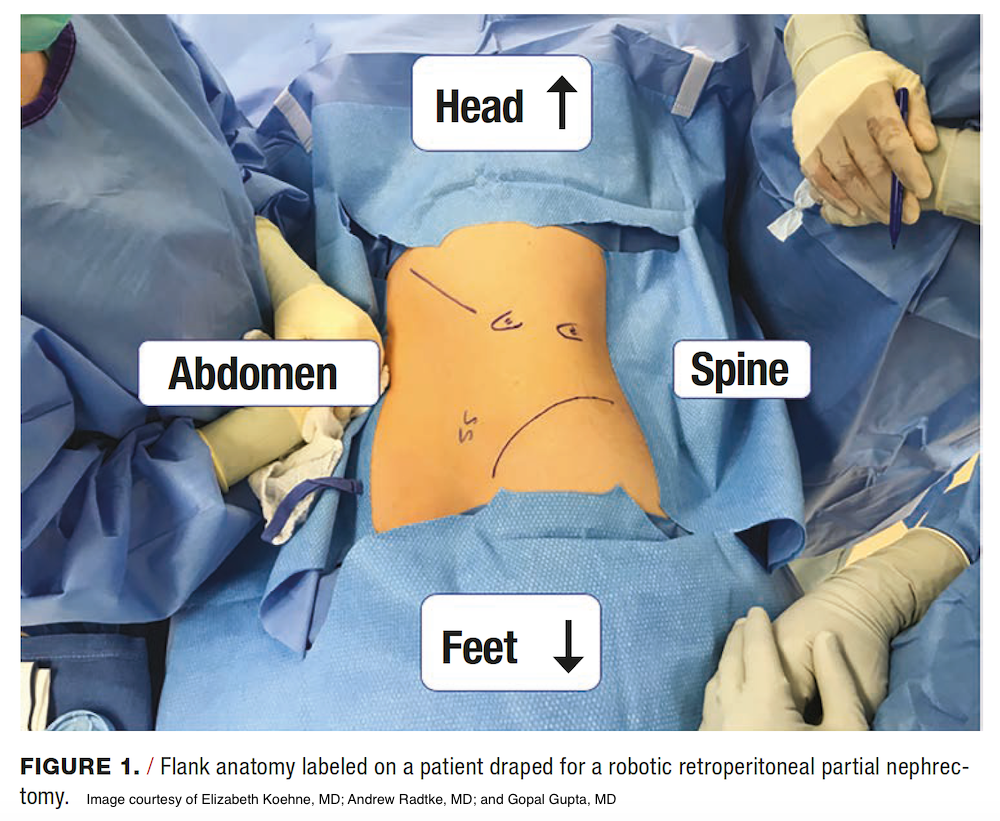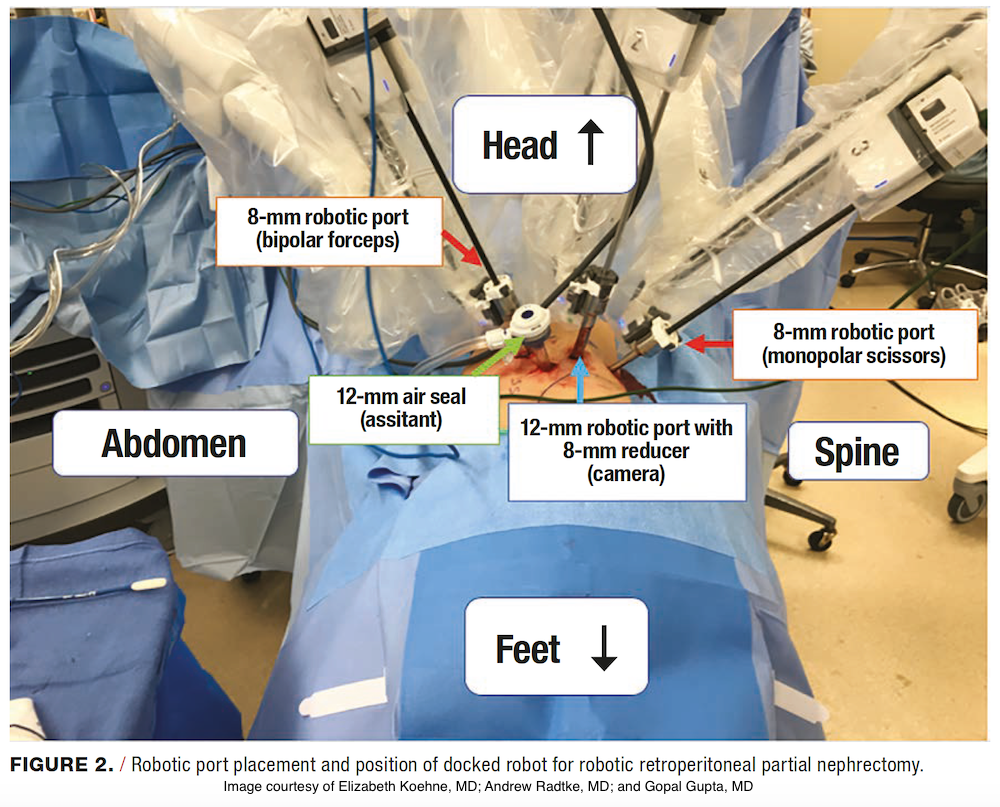Publication
Article
Urology Times Journal
Going “retro”: A perspective on robotic retroperitoneal renal surgery
Author(s):
Improvements in technology have renewed interest in the technique.
The majority of the literature on urologic robotic surgery centers around the transperitoneal approach. However, the robotic retroperitoneal approach is gaining momentum. The minimally invasive retroperitoneal approach to renal surgery was initially developed in the 1990s by urologists performing laparoscopic nephrectomies for benign conditions.1 They found that patients undergoing retroperitoneal laparoscopic nephrectomy resumed normal oral intake faster and had a trend toward lower postoperative narcotic requirements compared to their transperitoneal counterparts. Other groups adopted this technique and demonstrated shorter operative time,2,3 warm ischemia time, and hospital stay.3 However, the challenge of laparoscopic suturing in the retroperitoneal space may have prevented the widespread adoption of this approach. In the 2000s, urologists quickly embraced the robotic platform and now routinely perform robotic renal surgery employing the benefits of instrument articulation and 3D view.
These improvements in robotic technology have reinvigorated interest in retroperitoneal access for renal surgery. The robotic retroperitoneal approach again has been shown to decrease the length of hospital stay,4-6 decrease intraoperative blood loss,4,5 and shorten operative time.5,7 It offers direct access to the kidney without the need to mobilize the bowel and provides an avenue for urologists to avoid the hostile abdomen of a patient with prior abdominal surgery.8 Barriers to learning this technique may include the different perspective of hilar and renal anatomy, the smaller working space, and unfamiliarity with positioning, access, and docking the robot. However, once these are overcome, the benefits of retroperitoneal surgery are readily apparent.
Applications
The robotic retroperitoneal approach has been primarily implemented in partial nephrectomy cases but has also been used to perform radical nephrectomies,9 nephroureterectomies,10 pyeloplasties,11-13 and adrenalectomies.14,15 In the domain of partial nephrectomy, the retroperitoneal approach is thought to be especially useful for posterior and lateral tumors,15 but Arora et al showed that surgeons can take a retroperitoneal approach to anterior tumors without any difference in operative time, estimated blood loss, intra-operative complications, or postoperative complications.4
Benefits of the retroperitoneal approach
In retroperitoneal renal surgery, the kidney is quickly encountered after a brief dissection of the retroperitoneal space. Unlike transperitoneal surgery, there is no need to mobilize the bowel. The surgeon never encounters nor has to retract the liver or spleen. There is no need to kocherize the duodenum for right-sided cases, and the tail of the pancreas is never encountered on the left. The hilum, and particularly the renal artery, is readily accessible for clamping within minutes of docking without navigating the renal vein. This direct approach to the kidney and rapid hilar access with minimal dissection allows for a much shorter operative time compared with the transperitoneal approach.8 Any postoperative bleed or urine leak is contained in the retroperitoneum, which may prevent the development of an ileus and other morbidities.16 These benefits can be especially useful in patients with intra-abdominal adhesions, ventral hernias, or colostomies, or those who are on peritoneal dialysis, but can also be applied to routine renal or adrenal surgery. The proximal ureter, renal pelvis, adrenal gland, and regional lymph nodes have all been accessed using the retroperitoneal approach.

Key points on surgical technique
Patients should be placed in a full lateral decubitus position with the table slightly flexed to increase space between the ribs and iliac crest (Figure 1). An axillary roll is utilized, and the patient is secured and padded using a beanbag, foam, and tape. The camera port incision is made 2 fingerbreadths above the iliac crest in the midaxillary line. Blunt finger dissection is carried down to the thoracolumbar fascia, which is divided sharply with scissors. Development of the retroperitoneal space can be performed either using a finger or small balloon dissector. At this point, pneumo-retroperitoneum is established. Landmarks are identified, including the psoas muscle as the “floor” and transversus abdominus muscle as the “ceiling,” with the peritoneal reflection draping medially. A posterior 8-mm robotic port is placed under direct vision 8 cm from the camera port, and through this a Kittner laparoscopic dissector is used to medialize the peritoneal reflection. A second 8-mm robotic port is placed after the peritoneum has been mobilized. It is critical to place the anterior port after mobilizing the peritoneum to prevent the port from being placed transperitoneally. A 12-mm assistant port is subsequently placed just inferior and medial to the camera port in a similar fashion. Robotic port placement can be varied to optimize access to the lower versus upper pole of the kidney or retroperitoneal space. The robot is docked over the 12-mm camera port with a slight anterior rotation (Figure 2). Once the robot is docked, the kidney is elevated off the psoas muscle and the hilum is identified by the pulsation of the renal artery. When approaching the hilum, the renal artery is usually the first vessel encountered. If needed, the renal vein can be skeletonized. We do not routinely close the fascia of the port sites.

Conclusions
Robotic retroperitoneal surgery is a valuable technique in the surgeon’s toolbox. With more familiarity, surgeons can employ the benefits offered by this approach. We anticipate further advancements in this field in an effort to minimize postoperative morbidity and the use of health care resources. We also imagine the retroperitoneal approach in novel applications such as ureteroplasty and ureterolithotomy. The continued miniaturization and refinement of the robotic platform combined with improved surgeon comfort will facilitate future innovation and refinement of urologic surgery in the retroperitoneal space.
Koehne is a 5th-year urology resident at Loyola University Medical Center, Maywood, Illinois. Radtke completed a robotics/endourology fellowship at Loyola University Medical Center in June 2020 and is now in community practice in Green Bay, Wisconsin. Gupta is associate professor of urology, radiology, and surgery at Loyola University Medical Center.
References
1. McDougall EM, Clayman RV. Laparoscopic nephrectomy for benign disease: comparison of the transperitoneal and retroperitoneal approaches. J Endourol. 1996;10(1):45-49. doi:10.1089/end.1996.10.45
2. Desai MM, Strzempkowski B, Matin SF, et al. Prospective randomized comparison of transperitoneal versus retroperitoneal laparoscopic radical nephrectomy. J Urol. 2005;173(1):38-41. doi:10.1097/01.ju.0000145886.26719.73
3. Ng CS, Gill IS, Ramani AP, et al. Transperitoneal versus retroperitoneal laparoscopic partial nephrectomy: patient selection and perioperative outcomes. J Urol. 2005;174(3):846-849. doi:10.1097/01.ju.0000169259.49754.02
4. Arora S, Heulitt G, Menon M, et al. Retroperitoneal vs transperitoneal robot-assisted partial nephrectomy: comparison in a multi-institutional setting. Urology. 2018;120:131-137. doi:10.1016/j.urology.2018.06.026
5. Hughes-Hallett A, Patki P, Patel N, Barber NJ, Sullivan S, Thilagarajah R. Robot-assisted partial nephrectomy: a comparison of the transperitoneal and retroperitoneal approaches. J Endourol. 2013;27(7):869-874. doi:10.1089/end.2013.0023
6. Maurice MJ, Kaouk JH, Ramirez D, et al. Robotic partial nephrectomy for posterior tumors through a retroperitoneal approach offers decreased length of stay compared with the transperitoneal approach: a propensity-matched analysis. J Endourol. 2017;31(2):158-162. doi:10.1089/end.2016.0603
7. Choo SH, Lee SY, Sung HH, et al. Transperitoneal versus retroperitoneal robotic partial nephrectomy: matched-pair comparisons by nephrometry scores. World J Urol. 2014;32(6):1523-1529. doi:10.1007/s00345-014-1312-7
8. Wetterlin JJ, Blackwell RH, Capodice S, Kliethermes S, Quek ML, Gupta GN. Robotic-assisted laparoscopic partial nephrectomy: a comparison of approaches to the posterior renal mass. World J Clin Urol. 2016;5(1):60-65. doi:10.5410/wjcu.v5.i1.60
9. Patel MN, Kaul SA, Laungani R, et al. Retroperitoneal robotic renal surgery: technique and early results. J Robot Surg. 2009;3(1):1. doi:10.1007/s11701-009-0123-0
10. Rose K, Khan S, Godbole H, Olsburgh J, GUY’s and St. Thomas’ Robotics Group. Robotic assisted retroperitoneoscopic nephroureterectomy: first experience and the hybrid port technique. Int J Clin Pract. 2006;60(1):12-14. doi:10.1111/j.1368-5031.2006.00703.x
11. Kaouk JH, Hafron J, Parekattil S, et al. Is retroperitoneal approach feasible for robotic dismembered pyeloplasty: initial experience and long-term results. J Endourol. 2008;22(9):2153-2159. doi:10.1089/end.2008.0130
12. Cestari A, Buffi NM, Lista G, et al. Retroperitoneal and transperitoneal robot-assisted pyeloplasty in adults: techniques and results. Eur Urol. 2010;58(5):711-718. doi:10.1016/j.eururo.2010.07.020
13. Olsen LH, Rawashdeh YF, Jorgensen TM. Pediatric robot assisted retroperitoneoscopic pyeloplasty: a 5-year experience. J Urol. 2007;178(5):2137-2141. doi:10.1016/j.juro.2007.07.057
14. Park JH, Kim SY, Lee CR, et al. Robot-assisted posterior retroperitoneoscopic adrenalectomy using single-port access: technical feasibility and preliminary results. Ann Surg Oncol. 2013;20(8):2741-2745. doi:10.1245/s10434-013-2891-z
15. Koehne EL, Bajic P, Gupta GN. Robotic-assisted laparoscopic retroperitoneal adrenalectomy. Surg Oncol. 2019;31:7. doi:10.1016/j.suronc.2019.06.005
16. Patel M, Porter J. Robotic retroperitoneal surgery: a contemporary review. Curr Opin Urol. 2013;23(1):51-56. doi:10.1097/MOU.0b013e32835b61f4






















